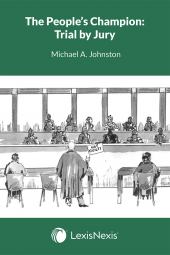Public-Private Partnerships in Canada: Law, Policy and Value for Money
One Year Subscription Only Terms
Subscribers receive the product(s) listed on the Order Form and any Updates made available during the annual subscription period. Shipping and handling fees are not included in the annual price.
Subscribers are advised of the number of Updates that were made to the particular publication the prior year. The number of Updates may vary due to developments in the law and other publishing issues, but subscribers may use this as a rough estimate of future shipments. Subscribers may call Customer Support at 800-833-9844 for additional information.
Subscribers may cancel this subscription by: calling Customer Support at 800-833-9844; emailing customer.support@lexisnexis.com; or returning the invoice marked 'CANCEL'.
If subscribers cancel within 30 days after the product is ordered or received and return the product at their expense, then they will receive a full credit of the price for the annual subscription.
If subscribers cancel between 31 and 60 days after the invoice date and return the product at their expense, then they will receive a 5/6th credit of the price for the annual subscription. No credit will be given for cancellations more than 60 days after the invoice date. To receive any credit, subscriber must return all product(s) shipped during the year at their expense within the applicable cancellation period listed above.
Détails des produits
Value for money for taxpayers is a touchstone for governments when procuring and building, operating and maintaining public assets and it is a benchmark public-private partnerships (P3s) have proven they can deliver. The Canadian approach to P3s has positioned the country as a global leader: With close to 300 projects over the last 15 years, the competitive marketplace for P3s in Canada has driven lower prices, leading governments at all levels to develop best practices that are a model to the world.
Public-Private Partnerships in Canada: Law, Policy and Value for Money highlights how that success was generated and what it will take to ensure it continues. This volume will be a valuable resource for a range of readers – whether you’re a public servant considering P3s in the context of the public interest, a lawyer trying to understand risk allocation, a businessperson assessing a P3 investment or a construction professional trying to parse how P3s differ from a standard form construction contract.
A comprehensive overview
Beginning with the history and policy context of P3s, this wide-ranging publication then goes on to explore how the risks associated with providing assets and services to taxpayers are managed and mitigated by the public and private sectors.
Overall, Public-Private Partnerships in Canada: Law, Policy and Value for Money offers extensive analysis and insight about a range of P3-related topics, including:
- The definition of P3s, a description of the common P3 models in Canada and an explanation of the contractual matrix behind the Design-Build-Finance-Maintain model
- The historical context of P3 development in Canada and an exploration of P3s across Canada – with the federal government and in each province
- An outline of the public policy factors both for and against P3s as a method of procuring the delivery of public assets and services as well as the characteristics that contribute to a successful P3 from the perspective of the public authority
- The legal and practical requirements for the procurement of a P3
- A broad overview of the key risks at play in a P3 and the general principles that underlie risk allocation
- A review of P3 projects and risk allocation from the perspective of private sector capital
- A detailed discussion of how risks are allocated in the project documentation among the private sector project participants
- An outline of the key agreements entered into by the parties to a P3 such as equity agreements, subcontractor agreements, agreements governing defaults and project-specific agreements
- An examination of dispute resolution in the P3 context
- A review of the challenges facing P3s in the municipal context and examples of municipal P3s in a variety of asset classes
- An overview of P3s in the U.S., including their historical development, how the U.S. approach compares to Canada’s, federal P3 initiatives, state legislation and agencies, advocacy institutions and recent advances in P3s in the U.S.
- An assessment of P3s as a tool for economic development in and reconciliation with Canada’s indigenous communities
Public-Private Partnerships in Canada: Law, Policy and Value for Money will be of interest to legal professionals, public servants, entrepreneurs and investors seeking to understand why and how Canadian P3s work. This book will be particularly useful for:
- Corporate/commercial lawyers
- Federal and provincial ministries and government bodies
- Private sector sponsors
- Financial institutions
- Insurance companies
- Pension plans and private equity companies
- Infrastructure companies
- Service providers and maintenance companies
- Engineering consulting firms
- Ratings agencies
Table des matières
Preface
Chapter 1: An introduction to public-private partnerships
1. P3s: Context and concepts
2. Common P3 models
3. The DBFM model
Chapter 2: P3s across Canada
1. Introduction
2. The federal government
3. Alberta
4. British Columbia
5. Manitoba
6. New Brunswick
7. Newfoundland and Labrador
8. Nova Scotia
9. Ontario
10. Prince Edward Island
11. Quebec
12. Saskatchewan
13. Northwest Territories
14. Nunavut
15. Yukon
16. Conclusion
Chapter 3: Assessing P3s – The public sector
1. Introduction
2. The public policy case for the P3 methodology
3. Addressing the arguments against P3s
4. Ensuring successful P3s
5. Conclusion
Chapter 4: The procurement process
1. Introduction
2. The procurement process in context
3. The legal framework of a procurement
4. Practical issues in procurement
5. Anatomy of a procurement
6. Request for expressions of interest
7. Request for qualifications
8. Request for proposals
9. Request for proposals – Technical and practical issues
10. Preparing a response to the RFP
11. Bid review: Compliance, evaluation and assessment
12. Selection of a preferred proponent
13. Negotiations with the preferred proponent
14. Commercial and financial close
Chapter 5: Risk allocation
1. Introduction
2. Key P3 project risks
3. The DBFM model: The key risks
4. Conclusion
Chapter 6: The project agreement
1. Introduction
2. The project agreement and the public sector
3. Private sector obligations under the project agreement
Chapter 7: Financing P3 projects
1. Introduction
2. Project finance: The basics
3. Types of financing structures in P3s
4. Common debt market participants in P3s in Canada
5. Financial market issues in P3s
6. Debt capital during the bid phase
7. Insurance
8. Managing revenue risk projects: A special case
9. Financial and operating requirements
10. Documenting the bid commitment
11. Documenting a successful transaction
12. Key financial terms and conditions
13. Other key terms and conditions
14. Intercreditor issues and enforcement
15. Other key financing agreements
16. Refinancing and secondary markets
Chapter 8: Pass down of risk part I: Common principles
1. Introduction
2. Key pass down principles
3. Equivalent project relief
4. Enforcement of parallel issues
5. Project company stranded risks
6. Conclusion
Chapter 9: Pass down of risk part II: Construction
1. Introduction
2. The contracts
3. Rights and obligations during construction
4. Rights and obligations relating to the operations period
5. Events of default and termination rights
Chapter 10: Pass down of risk part III: Operations, maintenance and rehabilitation
1. Introduction
2. The contracts
3. Rights and obligations during the operations period
4. Rights and obligations during construction
5. Managing revenue risk projects
6. Events of default and termination rights
Chapter 11: Other key agreements
1. Introduction
2. The equity agreements
3. Subcontractor agreements
4. Agreements governing defaults
5. Project specific agreements
Chapter 12: Dispute resolution (by Jason Annibale)
1. Introduction
2. The distinct characteristics of P3s
3. A distinct approach to dispute resolution
4. The contractors and subcontractors
5. Conclusion
Chapter 13: Municipalities and P3 projects
1. Introduction
2. Challenges facing P3s in the municipal context
3. Examples of municipal P3s in a variety of asset classes
4. Conclusion
Chapter 14: P3s in the United States
1. Introduction
2. Defining P3s in the United States
3. Historical development
4. Comparing the U.S. approach with Canadian P3s
5. Federal P3 initiatives
6. State legislation
7. Municipal home rule
8. State agencies
9. P3 advocacy institutions
10. Why P3s were slower to develop in the United States
11. Recent advances in P3s
12. Analysis by sector
13. Legislative outline for rebuilding America
Chapter 15: P3s and Indigenous communities: A tool for reconciliation
1. Introduction
2. A clear infrastructure gap
3. Challenges unique to Indigenous P3 projects
4. Economic development and P3s
Produits liés
-
 Construction Law in CanadaDate de sortie: May 31, 2010360,00 $
Construction Law in CanadaDate de sortie: May 31, 2010360,00 $ -
Nouveau!Précommander
 The People’s Champion: Trial by JuryNouveau!Date de sortie: December 31, 2024125,00 $
The People’s Champion: Trial by JuryNouveau!Date de sortie: December 31, 2024125,00 $ -
Nouveau!Précommander
 Construction Dispute Mediation: Theory and PracticeNouveau!Date de sortie: December 31, 2024155,00 $
Construction Dispute Mediation: Theory and PracticeNouveau!Date de sortie: December 31, 2024155,00 $
 Lexis Nexis
Lexis Nexis 